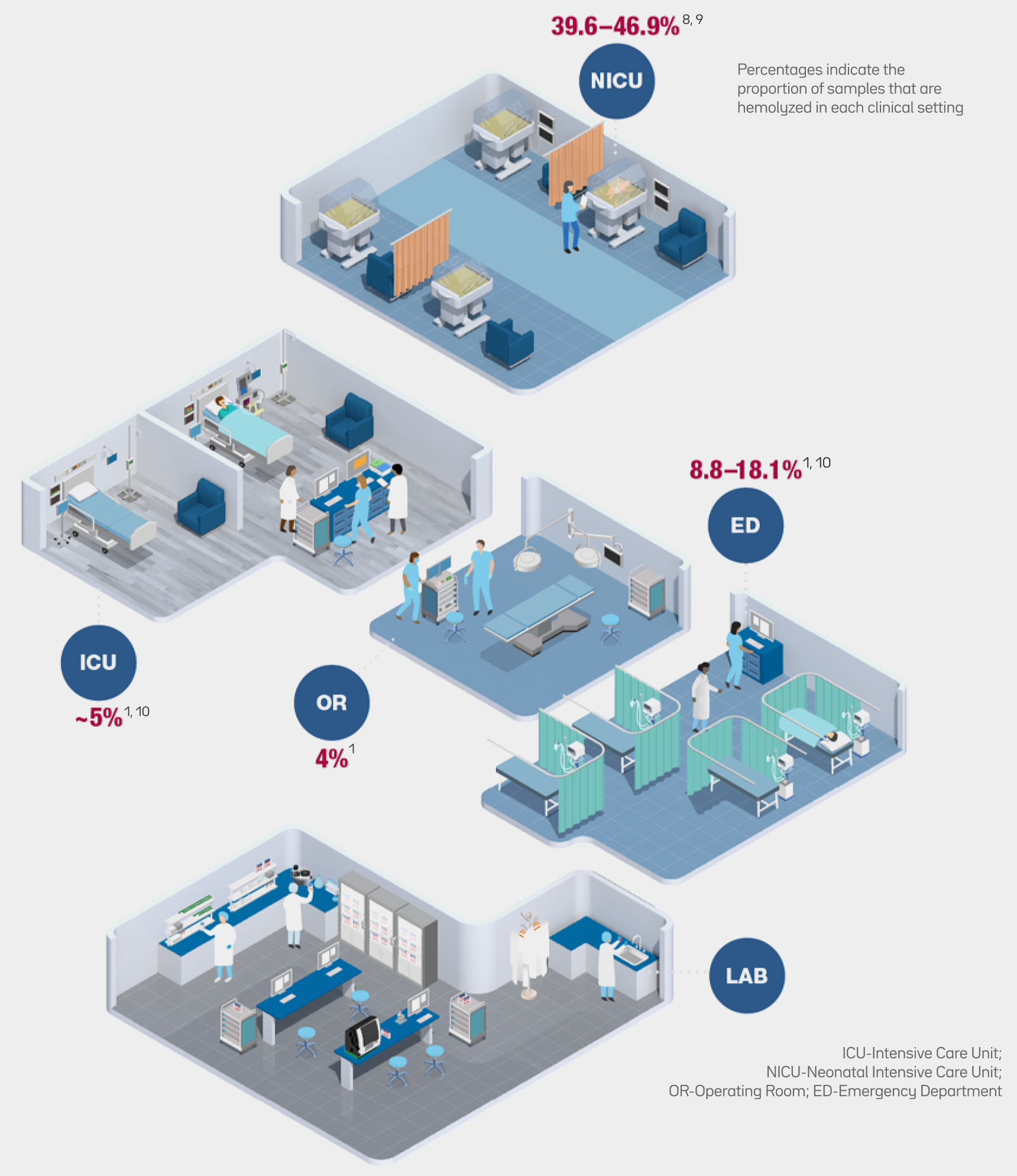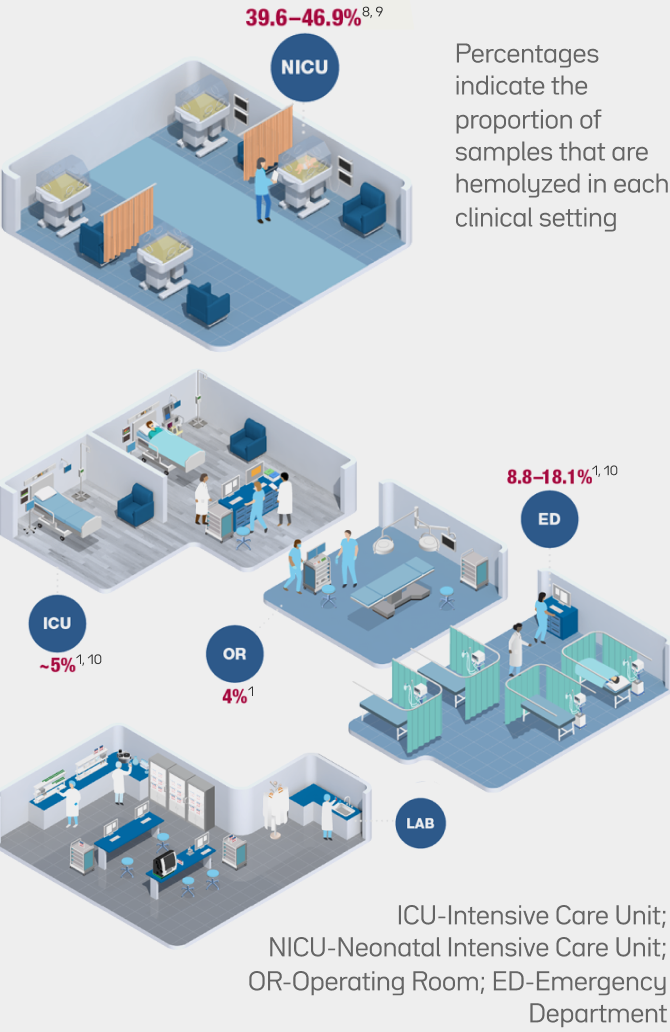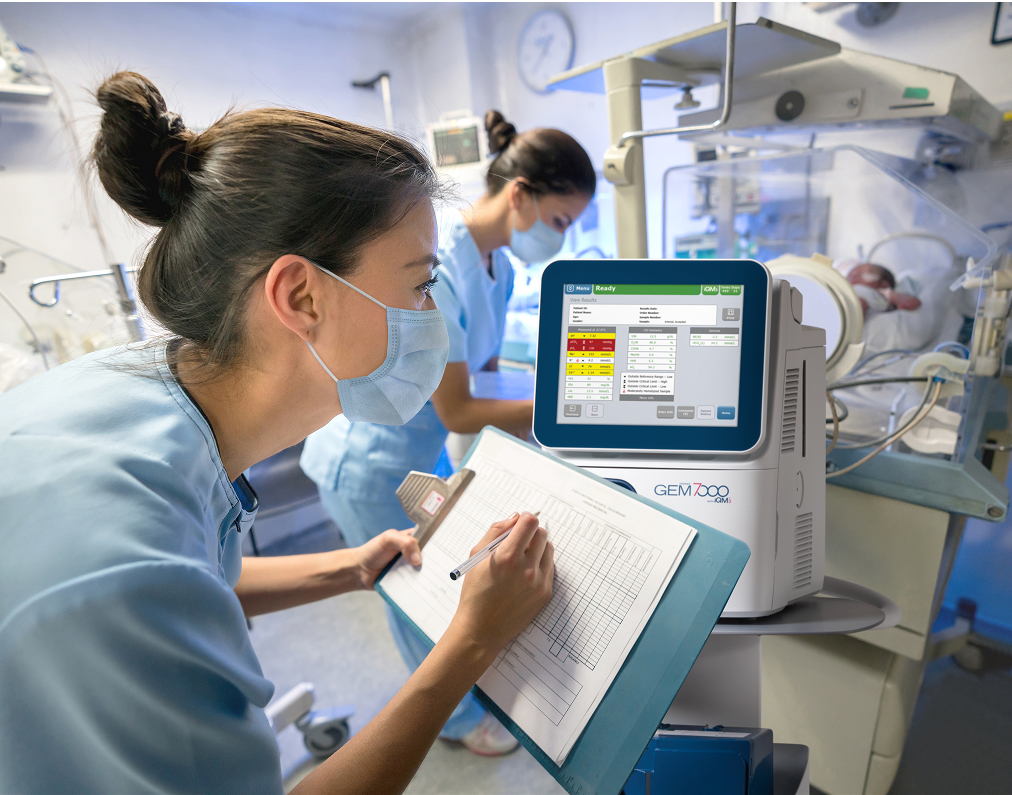Shine a light on a hidden problem
Hemolysis accounts for up to 70% of all preanalytical errors1

Introducing the GEM Premier 7000* with iQM3. The total blood gas system—now with hemolysis detection.
Consequences of in vitro hemolysis
Hemolysis occurs during routine blood testing at the point of care. When red blood cell membranes in the sample rupture, potassium (K+) leaks into the sample, leading to elevated K+ levels up to 152%.2 Impacted results in this blind spot can have a direct, negative impact on your most vulnerable patients.2–4
Inappropriate patient management 5–7
- Unsuitable or delayed treatment
- Longer length of stay
Inefficient staff/nursing time 5,7
- Unnecessary sample recollection
Decreased patient satisfaction 5–7
- Patient discomfort due to sample recollection
- Longer length of stay
Increased costs 5–7
- Unnecessary sample recollection
- Longer length of stay
Hemolysis is very prevalent, but largely unrecognized




Innovation meets accuracy
GEM Premier 7000 with iQM3 accurately determines the degree of hemolysis in whole blood, eliminating the need for centrifugation. It provides lab-quality results in any acute care setting.11


Express Hemolysis Detection delivers accurate results in just seconds
The GEM Premier 7000 provides blood gas results with hemolysis detection in 45 seconds at the point of care.12 This may reduce the need for sample recollection, or to send samples to the lab for recheck, saving blood and time.


Track-to-Train to go beyond detection
Go beyond detection and lower the most common preanalytical errors due to hemolysis and other sample-handling errors. GEMweb® Plus 500 Custom Connectivity tracks operators and locations to identify where further training is required. If needed, Werfen Academy can provide additional content for instruction.


Effective and efficient
Whole blood hemolysis detection can help reduce unnecessary sample collection, delays, and inappropriate treatment. Ultimately, it can help optimize staff time, reduce costs, and improve sample quality and patient management.4–7, 13
Hear what experts are saying about the GEM Premier 7000
GEM, Premier, GEM Premier ChemSTAT, ChemSTAT, GEMweb, iQM, Hemochron, VerifyNow, Avoximeter, and ROTEM are trademarks of Instrumentation Laboratory Company (d.b.a. Werfen) and/or one of its subsidiaries or parent companies and may be registered in the United States Patent and Trademark Office and in other jurisdictions. The Werfen logo is a trademark of Werfen and may be registered in the Patent and Trademark Offices of jurisdictions throughout the world. All other product names, company names, marks, logos, and symbols are trademarks of their respective owners.
©2025 Instrumentation Laboratory. All rights reserved.
*Not available in all countries.
References:
- Lippi G, Salvagna GL, Favaloro EJ, Guidi GC. Survey on the prevalence of hemolytic specimens in an academic hospital according to collection facility: opportunities for quality improvement. Clin Chem Lab Med. 2009;47(5):616-618. doi 10.1515/CCLM 2009132.
- Lippi G, Fontana R, Avazini p, Sandei F, Ippolito L. Influence of spurious hemolysis on blood gas analysis. Clin Chem Lab Med. 2013; 51(8):1651-1654. doi:10.1515/cclm-2012-0802.
- Lippi G, von Meyer A, Cadamuro J, Simund A-M. Blood sample quality. Diagnosis. 2019;6(1):25-31. doi:10.1515/dx-2018-0018.
- O’Hara M, Wheatley EG, Kazmierczak SC. The impact of undetected in vitro hemolysis or sample contamination on patient care and outcomes in point-of-care testing: a retrospective study. J Appl Lab Med. 2020;5(2):332-341. doi:10.1093/jalm/jfz020.
- Phelan MP, Hustey FM, Good DM, Reineks EZ. Seeing red: blood sample hemolysis is associated with prolonged emergency department throughput. J Appl Lab Med. 2020;5(4):732–737. doi:10.1093/jalm/jfaa073.
- Wilson M, Adelman S, Maitre JB, et al. Accuracy of hemolyzed potassium levels in the emergency department. West J Emerg Med. 2020;21(6):272–275. doi:10.5811/westjem.2020.8.46812.
- Milutinović D, Andrijević I, Ličina M, Andrijević L. Confidence level in venipuncture and knowledge on causes of in vitro hemolysis among healthcare professionals. Biochem Med. 2015;25(3):401–409. doi:10.11613/BM.2015.040.
- Tóth J, Oláh AV, Petercsák T, et al. Detection of haemolysis, a frequent preanalytical problem in the serum of newborns and adults. EJIFCC. 2020;31(1):6–14.
- Khedr S, Blake V, Erdogan E. Neonatal unit hemolysis rates from an academic medical center: A quality improvement project. Arch Path Lab. 2016;140(6):502–503. doi:10.5858/arpa.2015-0252-le.
- Nichols JH, Apple FS. Prevalence of hemolyzed results in acute care settings. J Appl Lab Med. 2023;8:431–434. doi:10.1093/jalm/jfac141.
- Balasubramanian S, McDowell EJ, Laryea ET, et al. Novel in-line hemolysis detection on a blood gas analyzer and impact on whole blood potassium results. Clin Chem. 2024;70(12):1485-1493. doi:10.1093/clinchem/hvae135.
- Werfen. GEM Premier 7000 with iQM3 Operators Manual. P/N 00000026407. Rev 00. Aug 2023.
- Phelan MP, Ramos C, Walker LE, et al. The hidden cost of hemolyzed blood samples in the emergency department. J Appl Lab Med. 2021;6(6):1607–1610. doi:10.1093/jalm/jfab035.